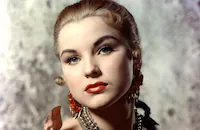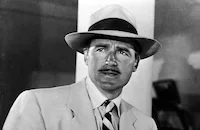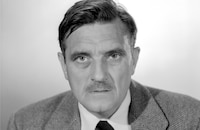From the Earth to the Moon

Brief Synopsis
Cast & Crew
Byron Haskin
Joseph Cotten
George Sanders
Debra Paget
Don Dobbins
Patric Knowles
Film Details
Technical Specs

Synopsis
In 1868 America, munitions mogul and inventor Victor Barbicane calls a meeting of the International Armaments Club at his sprawling mansion, Victory, to inform them of his development of an extremely powerful explosive, "Power X." Barbicane explains that a rocket carrying Power X could destroy an entire city and, because of its dangerous properties, proposes building a great rocket to travel to the moon where he will test the abilities of Power X. Numerous wealthy businessmen in the club, including Josef Cartier, author Jules Verne, banker Morgana and scientist Aldo Von Metz, agree to support Barbicane's fantastic project. Word rapidly spreads of Barbicane's construction of a "super-rocket," horrifying prominent metallurgist Stuyvesant Nicholl, a serious, religious man, who challenges Barbicane to a duel. When Barbicane refuses, Nicholl goes to Washington, D.C. where he reports to Congress that he has forged the hardest substance known to man and, insisting that Barbicane is lying about the potential of Power X, demands that Barbicane test it against his invention. Barbicane agrees and a test is soon arranged. Using only a few drops of Power X in a small bullet-shaped projectile, Barbicane not only completely annihilates Nicholl's metal shield, but demolishes the mountain behind it. Plans for building the rocket proceed, providing employment and enthusiasm in the region, until Barbicane is summoned by President Ulysses S. Grant to a secret meeting. Grant informs the inventor that many nations believe that Power X gives America an unfair military advantage over them and twenty-two nations have stated that if Barbicane's experiment is completed, they will consider it an act of war. Barbicane declares that as a scientist he has the right to test his invention, but Grant insists that internationally the trial is seen as a ruse to cover America's play for global dominance. Barbicane reluctantly agrees to call off his experiment and accedes to the president's request not to reveal the reasons for the decision. After Barbicane's announcement of the cancellation of the Power X rocket, disgruntled investors and an expectant public attack him in the press. Several businessmen led by Morgana demand to purchase Power X from Barbicane, but he rejects their offer. Undaunted, Barbicane continues his scientific inquiries and upon examining the small remains of Nicholl's shield from the test, learns that the fused material is indeed harder than any other substance. Barbicane realizes that he can use the substance to create a rocket that, fueled by Power X, will be safe enough to transport men into outer space. Barbicane meets with Nicholl and his daughter Virginia to request his help in building the rocket and, convinced that reaching the moon will be a great human achievement, Nicholl agrees. When the rocket is completed, Virginia christens it "Columbia," and unknown to her father, Barbicane and his young assistant Ben Sharpe, she then sneaks onboard and hides in one of the pressurized space suits. Unaware of the stowaway, the men climb into special acceleration tubes and the rocket is successfully launched. In the air, Barbicane toasts to their success, but Nicholl admits he believes that the flight flaunts God's natural laws. When the ship's enormous gyroscope goes awry, Nicholl confesses that he sabotaged the ship's rockets, determined to discredit Power X. When a gas leak prompts Ben to go below to retrieve the space suits, he is startled to find Virginia, who is dismayed to learn of her father's sabotage. Realizing the ship could explode at any moment, Barbicane attempts to repair Nicholl's damage, but is caught in an electronic burst in which Nicholl intentionally allows him to be shocked. Virginia is horrified by her father's behavior, but he insists he is doing God's will. Shortly after Barbicane recovers, the rocket flies into a meteor shower and Nicholl grudgingly admires the abilities of the Columbia. On Earth at an observatory tracking the rocket, Von Metz spots the great sparks given off by Columbia's flight through the meteors and believes the ship has been destroyed. Newspaper publisher Bancroft tells Barbicane's supporters that he suspects the entire flight is a hoax and that Barbicane has absconded with the contributors' funds and gone into hiding nearby. On board the rocket, Barbicane informs Nicholl of his intention to sell every nation on Earth Power X and his confidence that because mankind would rather live than destroy itself, the substance would eventually be used for the greater good. Stunned by the notion, Nicholl is contrite about trying to destroy Power X, but Barbicane tells him that Power X is found in nature and will be discovered again in time. Barbicane soon realizes the ship will be unable to escape the moon's gravitational pull unless they can fire the damaged rockets to break free. Nicholl comes to Barbicane's aid when he again attempts to make repairs. Barbicane then suggests they try firing the rockets, sending the return module toward Earth while the rest of the ship might be pushed toward the moon. Ben insists on helping, but Nicholl knocks him out and places him with the distraught Virginia in the module. Barbicane fires the rockets successfully, sending Ben and Virginia back to Earth while he and Nicholl fall to the moon. Noting the rocket's explosion from the observatory, Von Metz concludes the ship reached the moon only to blow up. As Ben guides the module to Earth, Virginia worries about her father until they see a small burst of light from the moon's surface. Virginia is delighted that Earth has seen the signal, but Ben points out that it came from the moon side facing away from Earth and was meant for them as a sign that Barbicane and Nicholl landed safely. Ben assures Virginia that other men will someday fly to the moon again and that Barbicane and Nicholl will never be forgotten.

Director

Byron Haskin
Cast

Joseph Cotten

George Sanders

Debra Paget
Don Dobbins

Patric Knowles

Carl Esmond

Henry Daniell

Melville Cooper

Ludwig Stossel

Morris Ankrum
Crew
Robert Blees
Benedict Bogeaus
Benedict Bogeaus
Carlos Carbajal
Weldon Coe
Edwin B. Du Par
Armando Espinosa
Luis Fernàndez
Louis Forbes
Agustín Jiménez
James Leicester
James Leicester
Rafael Portillo
Nacio Real
Ramón Rodríguez Granada
Albert M. Simpson
Gwen Wakeling
Hal Wilson Cox
Lee Zavitz
Lee Zavitz

Videos
Trailer
Hosted Intro
Film Details
Technical Specs

Articles
From the Earth to the Moon
From the Earth to the Moon features Joseph Cotten as a post-Civil War mad scientist who invents a source of infinite energy called Power X, a fuel he believes can propel a manned rocket to the moon and back. (Parallels to modern atomic weapons are also drawn strongly.) George Sanders plays a rival scientist and Debra Paget plays Sanders's daughter, who stows away on the rocket without too much trouble.
The movie suffered creatively from the demise of its original releasing company, RKO. (Warner Bros. handled the release instead.) This led to the film's budget being greatly slashed during production. The effects department suffered the greatest hit, and scenes on the moon were eliminated from the script. What remains once the rocket blasts off is a disappointingly verbose chamber drama aboard the rocket with little in the way of special effects.
All that leaves is the cast as probably the most interesting reason to take a look at From the Earth to the Moon. Cotten and Sanders are always worth watching, but also present are popular character actors Carl Esmond and Henry Daniell, both of whom excelled as suave, sinister villains in their careers. Among his many roles, the British Daniell played perhaps the best Prof. Moriarty to Basil Rathbone's Sherlock Holmes in The Woman in Green (1945). Esmond, an Austrian, appeared in everything from Sergeant York (1941) to Smash-Up: The Story of a Woman (1947), and he died just a few months ago in December 2004, at age 102. Morris Ankrum, who here plays Pres. Ulysses S. Grant, is fondly remembered for his many 1950s sci-fi films in which he usually played gruff military men, policemen or other officials.
From the Earth to the Moon had been made into movies prior to 1958 and it would be again. A famous Georges Melies short loosely based on the book appeared in 1902, and further screen versions appeared in 1914, 1967, and 1986 (a French TV movie). The title was also used for a 1998 HBO mini-series hosted by Tom Hanks.
Electronic sound effects lifted from Forbidden Planet (1956) were used as part of the score.
Producer: Benedict Bogeaus
Director: Bryon Haskin
Screenplay: Robert Blees, James Leicester, based on the novel by Jules Verne
Cinematography: Edwin B. DuPar
Editing: James Leicester
Music: Louis Forbes
Production Design: Hal Wilson Cox
Cast: Joseph Cotten (Victor Barbicane), George Sanders (Stuyvesant Nicholl), Debra Paget (Virginia Nicholl), Don Dubbins (Ben Sharpe), Patric Knowles (Josef Cartier), Carl Esmond (Jules Verne), Henry Daniell (Morgana), Morris Ankrum (President Ulysses S. Grant), Robert Clarke (Narrator).
C-100m. Closed captioning.
by Jeremy Arnold

From the Earth to the Moon
Quotes
Trivia
This was one of the last films produced for RKO. By the time it was completed, RKO had ceased production and distribution. It was released through Warner Brothers.
This went into production as RKO was preparing to shut down. It was believed to have had a much larger budget which was later cut. This greatly affected the quality of the special effects.
Among the last minute cost-cutting measures inflicted upon this film was the elimination of all scenes taking place on the moon.
Some of the music is actually the "electronic tonalities" created by Louis Barron and Bebe Barron for Forbidden Planet (1956).
Notes
The opening credits are presented in a leatherbound book, the cover of which states: "Warner Bros. presents From the Earth to the Moon by Jules Verne." A hand then opens the book to the first page which reads "Benedict Bogeaus Presents." The next page repeats the title and author credits as listed on the book's cover. Carl Esmond, who portrays a character referred to throughout the picture only as "J.V.," addresses the camera directly and identifies himself as "Jules Verne" at the end of the film.
According to a June 1948 Los Angeles Examiner article, producer-director William Castle intended to make a documentary based on French author's Verne's novel De la terre à la lune (From the Earth to the Moon), but that film was not produced. A June 1956 Los Angeles Times item stated that the novel would be made into a film to be produced by an unspecified company abroad, starring Genevieve Page. An October 1957 Hollywood Reporter news item indicates that Warner Bros. producer Bogeaus was to make From the Earth to the Moon and hoped to sign Errol Flynn for the lead role. A Daily Variety news item states that Lucienne Auclair, Miss Belgium 1957, would make her debut in the film, but her appearance in the film has not been confirmed.
Although a review indicates that the film was set in Florida, as was the novel, the exact location is not stated, only that the longitude and latitude of "Victor Barbicane's" mansion was "a day and night's journey from New York." The longitude and latitude stated in the film would place the story in Nebraska. The film was shot on location in Mexico. An August 1958 ^LAEx news item states that Bogeaus and special effects man Lee Zavitz, in collaboration with Technicolor engineers, had developed a new process called "Giantscope" which was said to be adaptable to color projection on all screens and would be used to photograph From the Earth to the Moon. There is no further information on the process.
On the print viewed, the closing credits include the RKO Radio Pictures logo. A March 1961 Daily Variety news item discloses that Bogeaus lost a suit filed against him by RKO General, Inc. for failure to deliver two films, including From the Earth to the Moon, to RKO for foreign distribution, an agreement made before RKO's exchange system was abandoned. Reviews of the film made note of contemporary international interest in space flights following the 1957 launch by the Soviet Union of the Sputnik satellite. In 1958, the National Aeronautical Space Agency (NASA) was established and America launched its first satellite, Explorer I, from Cape Canaveral, FL.
Verne's popular novel De la terre à la Lune was also published in English under the titles The Baltimore Gun Club and The American Gun Club as well as From the Earth to the Moon. The story's actual flight to the moon took place in the novel's 1870 sequel Autour de la lune (Round the Moon). Verne's novels were used as the basis for numerous films, including the early 1899 silent film by French filmmaker Georges Méliès, Le voyage dans la lune, and an expanded version by Méliès, with the same title, in 1902. In 1967 American International Productions released another version of the story, Those Fantastic Flying Fools, starring Burl Ives and Troy Donahue and directed by Don Stark (see AFI Catalog of Feature Films, 1961-70).

















